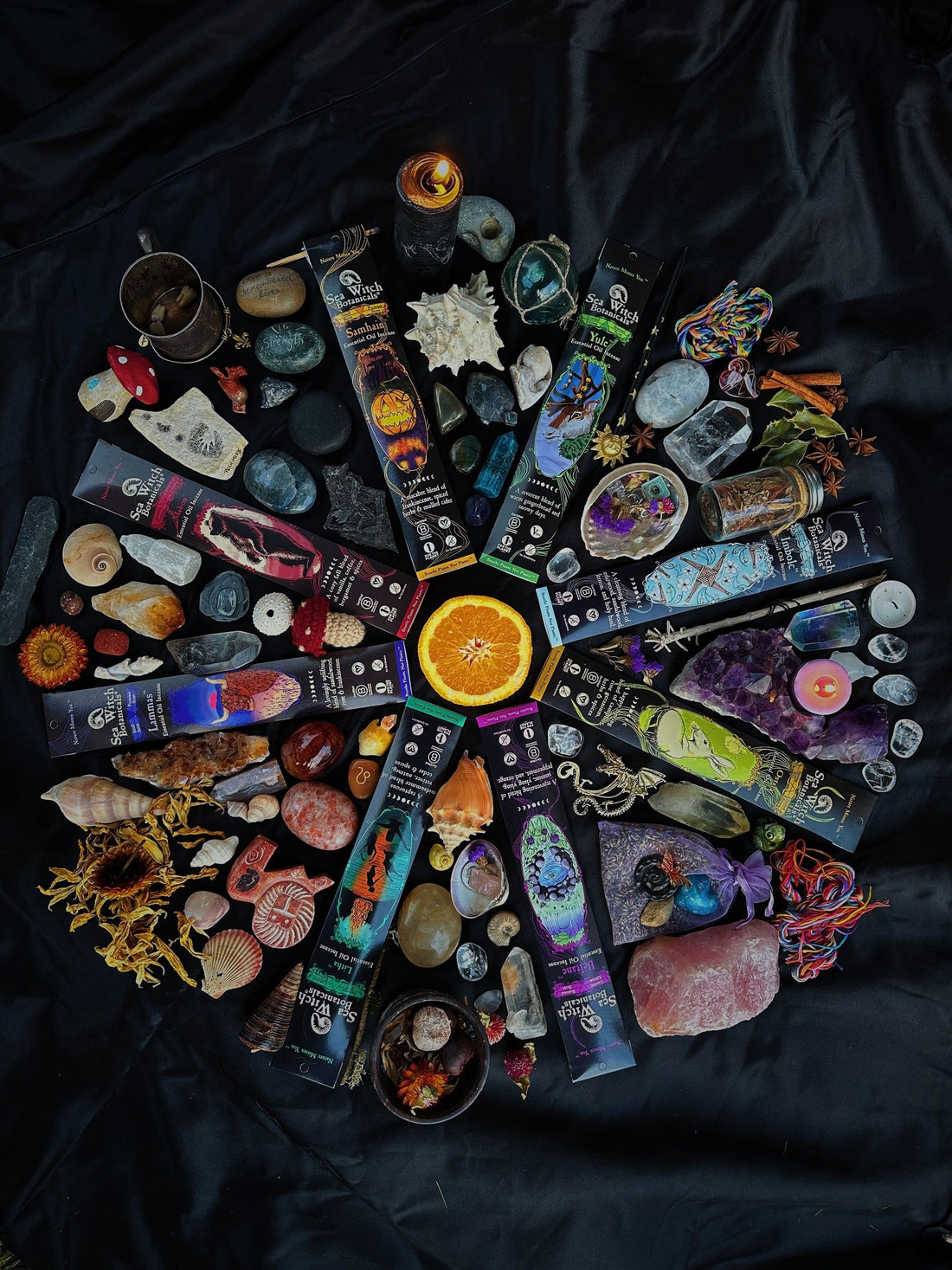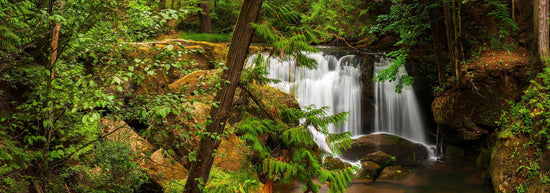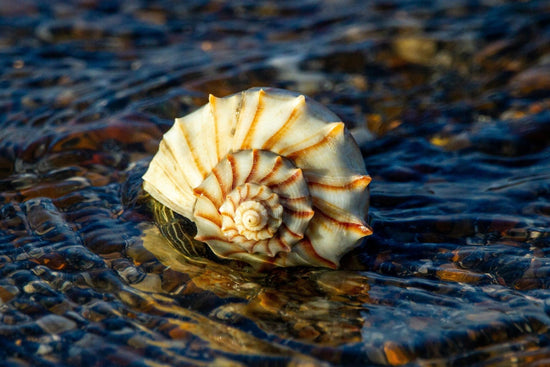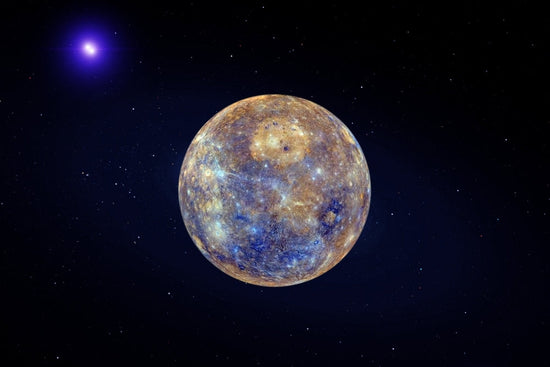If you’ve taken one step into the realm of modern paganism, you’ve probably encountered the Wheel of the Year—and if you’re new here, you’re probably wondering: What is this Wheel of the Year, anyway? Why is this centralized in so many pagan traditions today?
The Wheel of the Year is a modern conceptualization of cyclical seasonal celebrations that follow the ebb and flow of darkness and light over the course of a year. It contains eight holidays, or sabbats, altogether: four solar festivals (the equinoxes and solstices), and four fire festivals (each Celtic in origin, marking the halfway point between solstice and equinox). The calendar is heavily reliant on Celtic mythology and folk holidays, with some Germanic and Norse influences as well.
The Wheel was developed throughout the 50s, 60s, and 70s by the pioneers of Wicca, a modern witchcraft religion that draws many of its customs from various pagan traditions throughout time. While the holidays on the Wheel are historically evidenced throughout Europe, the Wheel concept itself holds no grounding in ancient pagan traditions. Its earliest appearance is in 1835 in Jacob Grimm’s Teutonic Mythology, or Deutsche Mythologie, a treatise on pre-Christian Germanic gods and myths.
As such, the Wheel is not observed by all witches or pagans, especially considering not all witches are pagan and not all pagans are witches. Many practitioners choose only to observe the holidays that align with their own traditions.
As we celebrate our freshly completed Wheel of the Year incense collection, we’re diving deep into the realm of the Wheel, giving a detailed look into each of the sabbats and their correspondences, and providing resources on how to celebrate. So grab your tea, spark your incense, and let’s dig in!
Yule | Winter Solstice
Photo by Yang Shuo on Unsplash
Yule celebrates the winter solstice, the longest night of the year. Occurring annually sometime between the 20th and 22nd of December (or June in the southern hemisphere), this solar festival is derived from the Norse Jól, Danish Jul, or Old English Geol. During the winter solstice, a space of utter stillness, quietude, and rest, the light of the sun is reborn. After the chill of midwinter’s solstice night, the days slowly begin to lengthen, and the singing promise of summer begins to trickle in. Use this time of Yule for reflection, honoring the dark, and spurring new hope.
Our Yule blend features ginger, nutmeg, cinnamon, orange, vanilla, frankincense, and benzoin in a warm, cozy scent reminiscent of cookies by the fireside on a snowy winter day.
Yule Associations
Colors: red, green, white, gold
Moon Phase: Dark or new moon
Botanicals: mistletoe, holly, wintergreen, ivy, poinsettia, pine, cedar, fir, spruce, juniper, birch, orange, cinnamon, clove, frankincense, myrrh
Stones: amber, emerald, bloodstone, red jasper, garnet, ruby, moonstone, diamond
Animals: goats, boars, reindeer, bears, wolves, stags, squirrels, owls, ravens, robins, cardinals
Foods: mulled ciders and wines (try this wassail recipe), gingerbread, roasted meat, apples, oranges, winter squash, root vegetables, nuts, dried fruit, sun bread
Altar Items & Decor: Yule log, evergreen garlands and wreaths, mistletoe ball, winter botanicals, wassail, red and green candles
Rituals: shadow work, cleansing, grounding, peace, hope, solar magic
Traditions: make a Yule altar, create a Yule log, make an evergreen garland or wreath, make a holly or mistletoe ball, bake Yule cookies, create Yule ornaments with dried fruit or gingerbread cookies, host a Yule feast and make merry with loved ones!
Find our Yule playlist on Spotify or YouTube for a mystical midwinter experience.
Imbolc | Imbolg

Photo by Daniel o'dowd on Unsplash
Imbolc celebrates the halfway point between the winter solstice and the vernal equinox. Occurring annually over February 1st and 2nd (or August in the southern hemisphere), this fire festival is derived from the Celtic holiday Imbolg, meaning in the belly or milking, a reference to pregnant ewes and the lambing season.
Imbolc is associated with Brighid (aka Brigid or Brigit), a fiery goddess of healing, poetry, blacksmithing, childbirth, and inspiration. In the process of Christianization, this goddess became conflated with Saint Brigid of Ireland, a patron saint of the isle. Imbolc then morphed into Candlemas, the feast day of the saint.
Imbolc celebrates the kindling of new life in the fires of the Earth. Use this time to initiate your spring cleaning: to sweep out the stagnation of wintertime and to set the stage for new beginnings to ignite.
Our Imbolc blend features cedarwood, sandalwood, lemon, holy basil, lavender, benzoin, and carrot in a cleansing, tenderly uplifting scent.
Imbolc Associations
Colors: brown, lavender, light blue, green, pink, white, grey
Moon Phase: New or waxing crescent moon
Botanicals: snowdrops, dandelions, chamomile, basil, bay, benzoin, rosemary, angelica, myrrh, cinnamon, cedar, rowan, vanilla
Stones: selenite, amethyst, blue lace agate, rose quartz, clear quartz, rhodonite, turquoise, bloodstone, onyx, ametrine
Animals: sheep, lambs, swans, snakes, cows, bears, stags, any hibernating creatures
Foods: oats, grains, breads, bread pudding, poppy, pumpkin, & sunflower seeds, dairy, eggs, pork, potatoes, onions, leeks (try this Irish Colcannon recipe), garlic, shallots, fermented foods, soup, stew, apple ciders, spiced wines, herbal teas
Altar Items & Decor: acorns, brooms, Brighid’s cross, candles, snowflakes, white flowers, corn dollies, green wreaths, sun totems, living plants
Rituals: awakening, cleansing, protection, divination, house blessing, healing
Traditions: make an Imbolc altar, spring cleaning, spiritual cleansing, make a dream sachet, plan your garden, work with fire, start a new project, craft, or hobby, host an Imbolc feast
Find our Imbolc playlist on Spotify or YouTube for an ethereal selection of cleansing pagan tunes.
Ostara | Vernal Equinox

Photo by Maddie H. on Unsplash
Ostara celebrates the vernal equinox, a day of equal dark and light. Occurring annually sometime between the 20th and 23rd of March (or September in the Southern Hemisphere), this solar festival was named in the 70s for a Germanic goddess of spring called Eostre (who may or may not have existed in ancient times).
Ostara centers growth: By the equinox of spring, the Earth is rich, fertile, and blushing with renewal, making this a sabbat for initiations, playful beginnings, and celebrations of new life.
Our Ostara blend features camphor, rose geranium, lemon, cedarwood, cinnamon leaf, frankincense, patchouli, white thyme, and benzoin in a lush scent dripping with fresh flowers and sunshine.
Ostara Associations
Colors: pink, green, yellow, white, light blue, anything pastel in hue
Moon Phase: First quarter moon
Botanicals: crocus, dandelion, tulips, daffodils, echinacea, goldenseal, hibiscus, honeysuckle, hyacinth, lilies, narcissus, violets, primrose, peony, hyssop, clover, alder, birch, dogwood
Stones: rose quartz, green jade, selenite, rhodonite, sunstone, aventurine, moss agate, amethyst, aquamarine, bloodstone
Animals: rabbits, newborns (chicks, ducklings, lambs, calves, etc.), caterpillars, butterflies, ladybugs, snakes, dragons
Foods: eggs, rabbit, lamb, seeds, leafy green vegetables (try dandelion greens!), fruits, sprouts, olives, yogurt, cupcakes, honeycakes, hot cross buns, fruit wines, milk & honey, mead
Altar Items & Decor: eggs (painted or otherwise), flower bulbs, seeds, balance imagery (sun and moon, black and white candles, etc), rose of Jericho, fresh flowers, living plants, green & white candles
Rituals: new beginnings, fertility, creativity, prosperity, emergence, divination, restoration, play
Traditions: make an Ostara altar, paint eggs, collect wildflowers, spring cleaning, cleansing, oomancy (egg divination), host an Ostara feast, plan a magical garden, charge seeds with intentions for planting at Beltane
Find our Ostara playlist on Spotify for jovial tunes celebrating the turning of spring.
Beltane | Bealtaine

Beltane celebrates the halfway point between the vernal equinox and the summer solstice. Occurring annually over April 30th into May 1st (or October into November in the Southern Hemisphere), this fire festival is derived from the Celtic Bealtaine, meaning bright fire. Mirroring with its counterpart on the wheel, Samhain, the veil between worlds grows extremely thin at this time of year, making this a day for warding off spirits and calling good fortune in.
This was traditionally the time when cattle were moved to their summer pastures, and is strongly associated with fertility rites, sex, and marriage. Use Beltane for dancing, noise-making, jumping over fires, and wild revelry.
Our Beltane blend features jasmine, ylang ylang, peppermint, orange, lavender, and frankincense in a heady, sensual scent flowering over with ideas to be ignited.
Beltane Associations
Colors: blue, pink, red, green, gold, yellow
Moon Phase: Waxing gibbous moon
Botanicals: oak, apple, hawthorne, birch, elder, ash, blackthorn, grapevine, rowan, holly, willow, cedar, yew, hemlock, hazel, dogwood, jasmine, rose, daffodil, tansy, honeysuckle, St. John’s wort, snapdragon, flox, lilac, primrose, blessed thistle, curry, coriander, fern, fire’s weed, nettle, flaxseed, marjoram, paprika, radish, rue, mushroom, almond, meadowsweet, woodruff, frankincense
Stones: carnelian, rose quartz, citrine, moonstone, malachite, garnet, emerald, beryl, tourmaline, amber, black obsidian
Animals: cows, sheep, goats, horses, rabbits, cats, butterflies, bees
Foods: dairy, oat cakes, cherries, strawberries, leafy greens, May wine, almond bread
Altar Items & Decor: salts, fresh flowers, fertility symbols, fire symbols, candles, chalices, honey, milk, oats, stone fruits, antlers & horns, swords, lances, arrows
Rituals: prosperity, fertility, conservation, protection, strengthening relationships, divination
Traditions: make a Beltane altar, collect morning dew, make flower crowns, plant seeds, dance around a maypole, manifest with fire, host a Beltane bonfire or feast
Find our Beltane playlist on Spotify or YouTube for invigorating, fire-infused pagan beats.
Litha | Summer Solstice

Litha celebrates the summer solstice, the longest day of the year. Occurring annually sometime between the 20th and 22nd of June (or December in the Southern Hemisphere), this solar festival is celebrated around the world.
The name Litha is derived from the Saxon calendar and was given to the summer solstice by Aidan Kelly in the 70s. This sabbat is a festival of light, sun, abundance, prosperity, and joy. At its peak, the warm sun shines down blessings for a plentiful harvest of ripened crops, levity, and delight.
Our Litha blend features vetiver, pink grapefruit, cinnamon leaf, nutmeg, cedarwood, fir needle, and frankincense in a smoky scent nostalgic for summer swims and bonfire nights.
Litha Associations
Colors: gold, orange, red, yellow, white, green, blue
Moon Phase: Full moon
Botanicals: calendula, St. John’s wort, sunflower, dandelion, rosemary, bay, lavender, sage, mint, basil, mistletoe, rowan, oak, chamomile, fennel, cinnamon, mugwort, oats, rose, rue, star anise, yarrow
Stones: sunstone, citrine, carnelian, pyrite, lapis lazuli, fluorite, amber, tiger’s eye
Animals: horses, butterflies, bees, fireflies, songbirds
Foods: summer fruits & vegetables, honeycakes, mead, cheese, sun-dried foods, sun tea
Alter Items & Decor: solar symbols, fresh flowers
Rituals: protection, love, divination
Traditions: make a Litha altar, see the sunrise, make protective amulets or pouches, cleanse with water, make a solar wheel or sun catcher, dance, play, build a Litha fire, burn your Yule wreath, manifest with herbs, host a Litha feast
Find our Litha playlist on Spotify or YouTube for revelry in the sun’s delight.
Lammas | Lughnasadh

Photo by Melissa Askew on Unsplash
Lammas celebrates the halfway point between the summer solstice and the autumnal equinox. Occurring annually on the first of August (or February in the Southern Hemisphere), this fire festival is derived from the Celtic Lughnasadh, meaning Lugh’s games. Lughnasadh was originally a festival held to honor the god Lugh’s foster mother Tailtiu, who cleared the lands of Ireland for agriculture.
Lammas, on the other hand, is the Christianized agricultural festival literally meaning loaf mass. Traditionally the first of three harvest festivals, this sabbat marks the beginning of the harvest season as the sun’s light begins to wane, making this a time for appreciating and reaping summer’s bounty.
Our Lammas blend features sandalwood, rose, frankincense, benzoin, bergamot, and rosemary in a refreshingly elegant scent for reveling in the summer’s boons.
Lammas Associations
Colors: yellow, gold, red, orange, brown, bronze
Moon Phase: Waning gibbous moon
Botanicals: grains, wheat, sunflower, corn, rose, mint, meadowsweet, apple, heather, hollyhock, ginseng, hops, calendula, fenugreek, grape leaves, sandalwood, frankincense, aloe
Stones: citrine, carnelian, amber, tourmaline, bloodstone, rutile or rutilated quartz
Animals: horses, oxen, cows, sheep, goats, pigs, roosters, bees
Foods: grains, breads, blueberries, blackberries, apples, carrots, squashes, pomegranates, cheese, ciders, fresh vegetables, herbs, corn, jellies, herbal sun teas, mead, beer, wine
Alter Items & Decor: sickles, scythes, fresh vegetables & fruits, grains, berries, corn dollies, bread, flowers, wheat stocks, yellow candles, corn, sheaves of grain
Rituals: harvest, gratitude, sacrifice
Traditions: make a Lammas altar, harvest the first boons from your garden, bake bread, make corn dollies, practice sports or crafts, save & dry seeds for next year, share your harvest, bless your tools for a rich harvest next year, host a Lammas feast
Find our Lammas playlist on Spotify or YouTube for bard-forward, whimsical solar tunes.
Mabon | Autumnal Equinox

Photo by Aaron Burden on Unsplash
Mabon celebrates the autumnal equinox, a day of equal light and dark. Occurring annually sometime between the 20th and 23rd of September (or March in the Southern Hemisphere), this solar festival was named for a Welsh god called Mabon ap Modron, whom we explore at length here.
The autumnal equinox is the second of three harvest festivals, and is traditionally the point at which fruits and vegetables are picked. At this point of perfect balance between the day and the night, Mabon is a time of celebrating the abundance the harvest has brought and preparing for winter as the dark season begins creeping in.
Our Mabon blend features coffee, bergamot, vanilla, nutmeg, clove, and cedarwood in a homey scent embodying everything you’d want to sip from a hot mug on a chilly autumn day.
Mabon Associations
Colors: red, brown, orange, gold, indigo
Moon Phase: Last quarter moon
Botanicals: cinnamon, clove, nutmeg, honeysuckle, marigold, passionflower, Solomon’s seal, milkweed, myrrh, tobacco, thistle, chamomile, garden sage, sweetgrass, pine, mugwort, rosemary, rosehips, yarrow, frankincense
Stones: red jasper, garnet, obsidian, tourmaline, labradorite, moonstone, sapphire, lapis lazuli, amber, topaz, citrine, amethyst, ametrine
Animals: bears, salmon, horses, boars, stags, geese, blackbirds, owls, eagles, herons, cranes
Foods: apples, grapes, cherries, pomegranates, corn, squashes, root vegetables, breads, nuts, grains, soups, stews, eggs, beans, roasted meats, ciders, wine, mead, beer
Alter Items & Decor: corn, autumn flowers & leaves, red poppies, nuts, grains, acorns, pinecones, corn or apple dolls, cornucopias
Rituals: balance, abundance, harvest, gratitude, grounding, protection, shadow work, divination
Traditions: make a Mabon altar, gather dried herbs and seeds to store for next year, make wine, go wassailing, give offerings to harvest fields, make a besom broom, share your harvest, express gratitude, host a Mabon feast
Find our Mabon playlist on Spotify or YouTube for a folksy, mystical autumn day.
Samhain | Samhuinn

Photo by freestocks on Unsplash
Samhain celebrates the halfway point between the autumnal equinox and the winter solstice. Occurring annually over October 31st into November 1st (or April in the Southern hemisphere), this fire festival is derived from the Celtic Samhain, Samain, or Samhuinn, meaning summer’s end.
This sabbat plunges us into the dark season, with sunlight waning day by day. At this time the veil between our world and the otherworld is believed to be the thinnest, and spirits may traipse seamlessly into our realm for communion and mischief-making alike. This makes Samhain a time for fire, protection spells, dressing up to trick the spirits, and veneration of the dead.
Our Samhain blend features frankincense, cinnamon, clove, orange, patchouli, and rosemary in a macabre scent evoking the autumnal spirit of darkness.
Samhain Associations
Colors: black, orange, brown, red, white, silver, gold
Moon Phase: Waning crescent or dark moon
Botanicals: allspice, catnip, mandrake, sage, nightshade, mugwort, rosemary, cinnamon, nutmeg, clove, patchouli, frankincense, mullein, chrysanthemums, bay, tobacco, rue, wormwood, mushroom
Stones: amber, obsidian, tourmaline, jet, howlite, selenite, smoky quartz, carnelian, iolite, aquamarine, opal, serpentine, spirit quartz
Animals: bats, dogs, cats (particularly black cats), spiders, owls, ravens, crows
Foods: turnips, apples, squashes, nuts, meats, mulled wines, pumpkin dishes, stew, soul cakes
Alter Items & Decor: ancestor totems, gourds, apples, besoms, jack o'lanterns, skulls or bones (ethically sourced)
Rituals: ancestor communion, shadow work, grounding, protection, divination
Traditions: make a Samhain altar, leave offerings for ancestors, honor the unknown dead, carve pumpkins, dress in costume to trick the wee folk, host a silent supper, host a Samhain bonfire or feast
Find our Samhain playlist on Spotify for a macabre selection of witchy pagan jams.







5 comments
Thank you so much for this clear and concise starter. I appreciate this info! And LOVE your insence!
Thank you so much for this. I have followed your playlists too!
Very interesting information. Love the linked Spotify playlists and recipes. Thank you!
Do you have a wheel of the year bundle? 😃🙌
Thank you so much for this in-depth yet concise post! Someone put a lot of time and effort into compiling all this information.